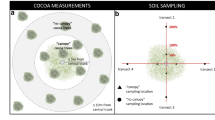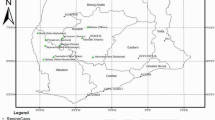Abstract
Farm product diversification, shade provision and low access to fertilizers often result in the purposeful integration of upper canopy trees in cocoa (Theobroma cacao) plantations. Subsequent modification to light and soil conditions presumably affects nutrient availability and cocoa tree nutrition. However, the level of complementarity between species requires investigation to minimize interspecific competition and improve resource availability. We hypothesized beneficial effects of upper canopy trees on cocoa biomass, light regulation, soil fertility and nutrient uptake. We measured cocoa standing biomass and soil nutrient stocks under no shade (monoculture) and under three structurally and functionally distinct shade trees: Albizia zygia (D.C.) Macbr, a nitrogen fixer; Milicia excelsa (Welw.), a native timber species; and Newbouldia laevis (Seem.), a native small stature species. Vector analysis was employed to diagnosis tree nutrition. Cocoa biomass was higher under shade (22.8 for sole cocoa versus 41.1 Mg ha−1 for cocoa under Milicia), and declined along a spatial gradient from the shade tree (P < 0.05). Percent canopy openness differed between the three shade species (P = 0.0136), although light infiltration was within the optimal range for cocoa production under all three species. Soil exchangeable K was increased under Newbouldia, while available P decreased and total N status was unaffected under all shade treatments. Nutrient uptake by cocoa increased under shade (43–80% and 22–45% for N and P, respectively), with K (96–140%) as the most responsive nutrient in these multistrata systems. Addition of low-density shade trees positively affected cocoa biomass close to the shade tree, however proper management of upper stratum trees is required for optimum cocoa productivity and sustainability.



Similar content being viewed by others
References
Ahenkorah Y, Halm BJ, Appiah MR, Akrofi GS, Yirenkyi JEK (1987) Twenty years’ results from a shade and fertilizer trial on Amazon cocoa (Theobroma cacao) in Ghana. Exp Agric 23: 31–39
Allen SE (eds) (1974) Chemical analysis of ecological materials. John Wiley & Sons, New York
Alpizar L, Fassbender HW, Heuveldop J, Folster H, Enriquez G (1986) Modeling agroforestry systems of cacao (Theobroma cacao) with laurel (Cordia alliodora) and poró (Erythrina poeppigiana) in Costa Rica. I Inventory of organic matter and nutrients. Agrofor Syst 4:175–189
Amanor KS (1994). The new frontier; farmers response to land degradation. A West African study. UNRISD, London, England, pp 171
Anderson JM, Ingram JSI (eds) (1993). Tropical soil biology and fertility: a handbook of methods. CAB International, Wallingford, UK, pp 10–15
Anim-Kwapong GJ (2003) Potential of some Neotropical Albizia species as shade trees when replanting cacao in Ghana. Agrofor Syst 58: 185–193
Barber SA (1984) Soil nutrient bioavailability: a mechanistic approach. John Wiley and Sons, Inc. Canada, pp 229–256
Beer J (1988) Litter production and nutrient cycling in coffee (Coffea arabica) or cacao (Theobroma cacao) plantations with shade trees. Agrofor Syst 7:103–114
Beer J, Muschler R, Kass D, Somarriba E (1998) Shade management in coffee and cacao plantations. Agrofor Syst 38:139–164
Boyer J (1973) Cycles de la matiere organique des elements mineraux dans une cacaoyere camerounaise. Cafe´ Cacao The´ 18:3–30
Brown S (1989, 1997) Estimating biomass and biomass change of tropical forests: a primer
Cunningham RK, Arnold PW (1962) The shade and fertilizer requirements of cacao (Theobroma cacao) in Ghana. J Sci Food Agr 13: 213–221
Ewel JJ, Bigelow SW (1996) Plant life-forms and tropical ecosystem functioning. In: Orians G, Dirzo D., Cushman C (eds) Biodiversity and ecosystem processes in tropical forests, Springer-Verlag, Berlin, Germany, pp 101–123
FAO Forestry Paper 134. Food and Agriculture Organization of the United Nations, Rome, Italy
Fassbender HW, Beer J, Heuveldop J, Imback A, Enriquez G, Bonnemann A (1991) Ten year balances of organic matter and nutrients in agroforestry systems at CATIE, Costa Rica. For Ecol Manage 45:173–183
Galyuon IKA, McDavid FB, Lopez FB, Spence JA (1996) The effect of irradiance level on cocoa (Theobroma cacao L.): 1. Growth and leaf adaptations. Tropical Agriculture Trinidad 73:23–28
Gap Light Analyzer, Version 2 (1999) Simon Fraser University, British Columbia, Canada and the Institute of Ecosystem Studies, New York, USA
Haase DL, Rose R (1995) Vector analysis and its use for interpreting plant nutrient shifts in response to silvicultural treatments. For Sci 41:54–66
Hartemink AE (2005) Nutrient stocks, nutrient cycling, and soil changes in cocoa ecosystems: a review. Adv Agro 86:227–253
Hooper DU (1998) The role of complementarity and competition in ecosystem responses to variation in plant diversity. Ecology 79:704–719
Imo M, Timmer VR (1997) Vector diagnosis of nutrient dynamics in mesquite seedlings. For Sci 43: 268–273
Isaac ME, Gordon AM, Thevathasan N, Oppong SK, Quashie-Sam J (2005) Temporal changes in soil carbon and nitrogen in west African multistrata agroforestry systems: a chronosequence of pools and fluxes. Agrofor Syst 65:23–31
Kummerow J, Kummerow M, Da Silva WS (1982) Fine root growth dynamics in cacao (Theobroma cacao). Plant Soil 65:193–201
Manu M, Tetteh EK (1987) A guide to cocoa cultivation. Cocoa Research Institute of Ghana, Ghana Cocoa Board, Accra
Nygren P, Ramírez C (1995) Production and turnover of N2 fixing nodules in relation to foliage development in periodically pruned Erythrina poeppigiana (Leguminosae) trees. For Ecol Man 73:59–73
Ofori-Frimpong K, Rowell DL (1999) The decomposition of cocoa leaves and their effect on phosphorus dynamics in tropical soil. Euro J Soil Sci 50:165–172
Schroth G, Lehmann J, Rodrigues MRL, Barros E, Macedo JL (2001) Plant-soil interactions in multistrata agroforestry in the humid tropics. Agrofor Syst 53:85–102
Silver WL, Brown S, Lugo A (1996) Biodiversity and biogeochemical cycles. In: Orians G, Dirzo D, Cushman C (eds) Biodiversity and ecosystem processes in tropical forests. Springer-Verlag, Berlin, Germany, pp 49–65
Soil Survey Division. (1969). Great Soil Groups. Survey of Ghana, Accra, Ghana
Tilman D (1999). The ecological consequences of changes in biodiversity: a search for general principles. Ecology 80:1455–1474
Vandermeer J (1989) The Ecology of Intercropping. Cambridge University Press, Cambridge, UK, pp 68–85
Zuidema PA, Leffelaar PA, Gerristsma W, Mommer L, Anten NPR (2005) A physiological production model for cocoa (Theobroma cacao): Model presentation, validation, application. Agri Syst 84: 95–225
Acknowledgements
We would like to thank farmer collaborators in the Sefwi Wiawso District, Ghana. We are also grateful to the Faculty of Renewable Natural Resources, Kwame Nkrumah University of Science and Technology, Ghana, for research support. We would like to acknowledge field and laboratory assistance by J. Hagan, Y. Teng, and E. Benczkowski and constructive critical comments by two anonymous journal reviewers. Financial support for this study was provided by the Natural Science and Engineering Research Council of Canada.
Author information
Authors and Affiliations
Corresponding author
Rights and permissions
About this article
Cite this article
Isaac, M.E., Timmer, V.R. & Quashie-Sam, S.J. Shade tree effects in an 8-year-old cocoa agroforestry system: biomass and nutrient diagnosis of Theobroma cacao by vector analysis. Nutr Cycl Agroecosyst 78, 155–165 (2007). https://doi.org/10.1007/s10705-006-9081-3
Received:
Accepted:
Published:
Issue Date:
DOI: https://doi.org/10.1007/s10705-006-9081-3




